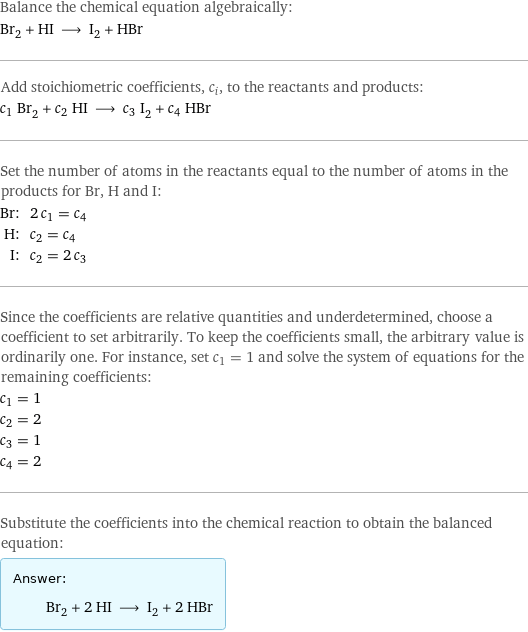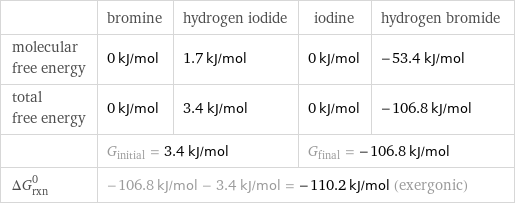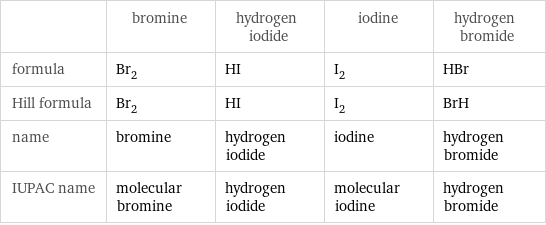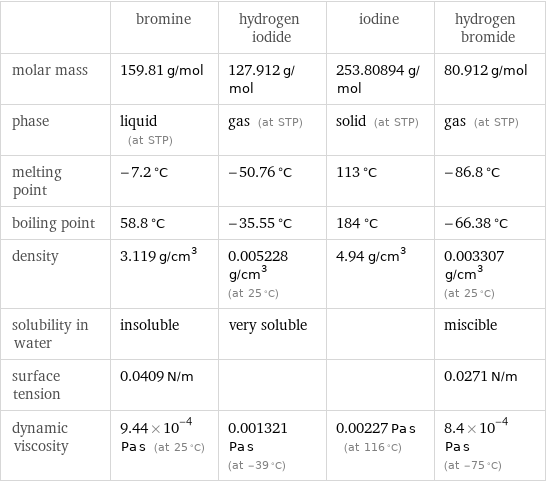Input interpretation

Br_2 bromine + HI hydrogen iodide ⟶ I_2 iodine + HBr hydrogen bromide
Balanced equation

Balance the chemical equation algebraically: Br_2 + HI ⟶ I_2 + HBr Add stoichiometric coefficients, c_i, to the reactants and products: c_1 Br_2 + c_2 HI ⟶ c_3 I_2 + c_4 HBr Set the number of atoms in the reactants equal to the number of atoms in the products for Br, H and I: Br: | 2 c_1 = c_4 H: | c_2 = c_4 I: | c_2 = 2 c_3 Since the coefficients are relative quantities and underdetermined, choose a coefficient to set arbitrarily. To keep the coefficients small, the arbitrary value is ordinarily one. For instance, set c_1 = 1 and solve the system of equations for the remaining coefficients: c_1 = 1 c_2 = 2 c_3 = 1 c_4 = 2 Substitute the coefficients into the chemical reaction to obtain the balanced equation: Answer: | | Br_2 + 2 HI ⟶ I_2 + 2 HBr
Structures

+ ⟶ +
Names

bromine + hydrogen iodide ⟶ iodine + hydrogen bromide
Reaction thermodynamics
Enthalpy

| bromine | hydrogen iodide | iodine | hydrogen bromide molecular enthalpy | 0 kJ/mol | 26.5 kJ/mol | 0 kJ/mol | -36.3 kJ/mol total enthalpy | 0 kJ/mol | 53 kJ/mol | 0 kJ/mol | -72.6 kJ/mol | H_initial = 53 kJ/mol | | H_final = -72.6 kJ/mol | ΔH_rxn^0 | -72.6 kJ/mol - 53 kJ/mol = -125.6 kJ/mol (exothermic) | | |
Gibbs free energy

| bromine | hydrogen iodide | iodine | hydrogen bromide molecular free energy | 0 kJ/mol | 1.7 kJ/mol | 0 kJ/mol | -53.4 kJ/mol total free energy | 0 kJ/mol | 3.4 kJ/mol | 0 kJ/mol | -106.8 kJ/mol | G_initial = 3.4 kJ/mol | | G_final = -106.8 kJ/mol | ΔG_rxn^0 | -106.8 kJ/mol - 3.4 kJ/mol = -110.2 kJ/mol (exergonic) | | |
Equilibrium constant
![Construct the equilibrium constant, K, expression for: Br_2 + HI ⟶ I_2 + HBr Plan: • Balance the chemical equation. • Determine the stoichiometric numbers. • Assemble the activity expression for each chemical species. • Use the activity expressions to build the equilibrium constant expression. Write the balanced chemical equation: Br_2 + 2 HI ⟶ I_2 + 2 HBr Assign stoichiometric numbers, ν_i, using the stoichiometric coefficients, c_i, from the balanced chemical equation in the following manner: ν_i = -c_i for reactants and ν_i = c_i for products: chemical species | c_i | ν_i Br_2 | 1 | -1 HI | 2 | -2 I_2 | 1 | 1 HBr | 2 | 2 Assemble the activity expressions accounting for the state of matter and ν_i: chemical species | c_i | ν_i | activity expression Br_2 | 1 | -1 | ([Br2])^(-1) HI | 2 | -2 | ([HI])^(-2) I_2 | 1 | 1 | [I2] HBr | 2 | 2 | ([HBr])^2 The equilibrium constant symbol in the concentration basis is: K_c Mulitply the activity expressions to arrive at the K_c expression: Answer: | | K_c = ([Br2])^(-1) ([HI])^(-2) [I2] ([HBr])^2 = ([I2] ([HBr])^2)/([Br2] ([HI])^2)](../image_source/bc6c68f88b5a3900b4cea15054b7f718.png)
Construct the equilibrium constant, K, expression for: Br_2 + HI ⟶ I_2 + HBr Plan: • Balance the chemical equation. • Determine the stoichiometric numbers. • Assemble the activity expression for each chemical species. • Use the activity expressions to build the equilibrium constant expression. Write the balanced chemical equation: Br_2 + 2 HI ⟶ I_2 + 2 HBr Assign stoichiometric numbers, ν_i, using the stoichiometric coefficients, c_i, from the balanced chemical equation in the following manner: ν_i = -c_i for reactants and ν_i = c_i for products: chemical species | c_i | ν_i Br_2 | 1 | -1 HI | 2 | -2 I_2 | 1 | 1 HBr | 2 | 2 Assemble the activity expressions accounting for the state of matter and ν_i: chemical species | c_i | ν_i | activity expression Br_2 | 1 | -1 | ([Br2])^(-1) HI | 2 | -2 | ([HI])^(-2) I_2 | 1 | 1 | [I2] HBr | 2 | 2 | ([HBr])^2 The equilibrium constant symbol in the concentration basis is: K_c Mulitply the activity expressions to arrive at the K_c expression: Answer: | | K_c = ([Br2])^(-1) ([HI])^(-2) [I2] ([HBr])^2 = ([I2] ([HBr])^2)/([Br2] ([HI])^2)
Rate of reaction
![Construct the rate of reaction expression for: Br_2 + HI ⟶ I_2 + HBr Plan: • Balance the chemical equation. • Determine the stoichiometric numbers. • Assemble the rate term for each chemical species. • Write the rate of reaction expression. Write the balanced chemical equation: Br_2 + 2 HI ⟶ I_2 + 2 HBr Assign stoichiometric numbers, ν_i, using the stoichiometric coefficients, c_i, from the balanced chemical equation in the following manner: ν_i = -c_i for reactants and ν_i = c_i for products: chemical species | c_i | ν_i Br_2 | 1 | -1 HI | 2 | -2 I_2 | 1 | 1 HBr | 2 | 2 The rate term for each chemical species, B_i, is 1/ν_i(Δ[B_i])/(Δt) where [B_i] is the amount concentration and t is time: chemical species | c_i | ν_i | rate term Br_2 | 1 | -1 | -(Δ[Br2])/(Δt) HI | 2 | -2 | -1/2 (Δ[HI])/(Δt) I_2 | 1 | 1 | (Δ[I2])/(Δt) HBr | 2 | 2 | 1/2 (Δ[HBr])/(Δt) (for infinitesimal rate of change, replace Δ with d) Set the rate terms equal to each other to arrive at the rate expression: Answer: | | rate = -(Δ[Br2])/(Δt) = -1/2 (Δ[HI])/(Δt) = (Δ[I2])/(Δt) = 1/2 (Δ[HBr])/(Δt) (assuming constant volume and no accumulation of intermediates or side products)](../image_source/def9a9bc1fbb3d46ec8196afb10d7c52.png)
Construct the rate of reaction expression for: Br_2 + HI ⟶ I_2 + HBr Plan: • Balance the chemical equation. • Determine the stoichiometric numbers. • Assemble the rate term for each chemical species. • Write the rate of reaction expression. Write the balanced chemical equation: Br_2 + 2 HI ⟶ I_2 + 2 HBr Assign stoichiometric numbers, ν_i, using the stoichiometric coefficients, c_i, from the balanced chemical equation in the following manner: ν_i = -c_i for reactants and ν_i = c_i for products: chemical species | c_i | ν_i Br_2 | 1 | -1 HI | 2 | -2 I_2 | 1 | 1 HBr | 2 | 2 The rate term for each chemical species, B_i, is 1/ν_i(Δ[B_i])/(Δt) where [B_i] is the amount concentration and t is time: chemical species | c_i | ν_i | rate term Br_2 | 1 | -1 | -(Δ[Br2])/(Δt) HI | 2 | -2 | -1/2 (Δ[HI])/(Δt) I_2 | 1 | 1 | (Δ[I2])/(Δt) HBr | 2 | 2 | 1/2 (Δ[HBr])/(Δt) (for infinitesimal rate of change, replace Δ with d) Set the rate terms equal to each other to arrive at the rate expression: Answer: | | rate = -(Δ[Br2])/(Δt) = -1/2 (Δ[HI])/(Δt) = (Δ[I2])/(Δt) = 1/2 (Δ[HBr])/(Δt) (assuming constant volume and no accumulation of intermediates or side products)
Chemical names and formulas

| bromine | hydrogen iodide | iodine | hydrogen bromide formula | Br_2 | HI | I_2 | HBr Hill formula | Br_2 | HI | I_2 | BrH name | bromine | hydrogen iodide | iodine | hydrogen bromide IUPAC name | molecular bromine | hydrogen iodide | molecular iodine | hydrogen bromide
Substance properties

| bromine | hydrogen iodide | iodine | hydrogen bromide molar mass | 159.81 g/mol | 127.912 g/mol | 253.80894 g/mol | 80.912 g/mol phase | liquid (at STP) | gas (at STP) | solid (at STP) | gas (at STP) melting point | -7.2 °C | -50.76 °C | 113 °C | -86.8 °C boiling point | 58.8 °C | -35.55 °C | 184 °C | -66.38 °C density | 3.119 g/cm^3 | 0.005228 g/cm^3 (at 25 °C) | 4.94 g/cm^3 | 0.003307 g/cm^3 (at 25 °C) solubility in water | insoluble | very soluble | | miscible surface tension | 0.0409 N/m | | | 0.0271 N/m dynamic viscosity | 9.44×10^-4 Pa s (at 25 °C) | 0.001321 Pa s (at -39 °C) | 0.00227 Pa s (at 116 °C) | 8.4×10^-4 Pa s (at -75 °C)
Units
